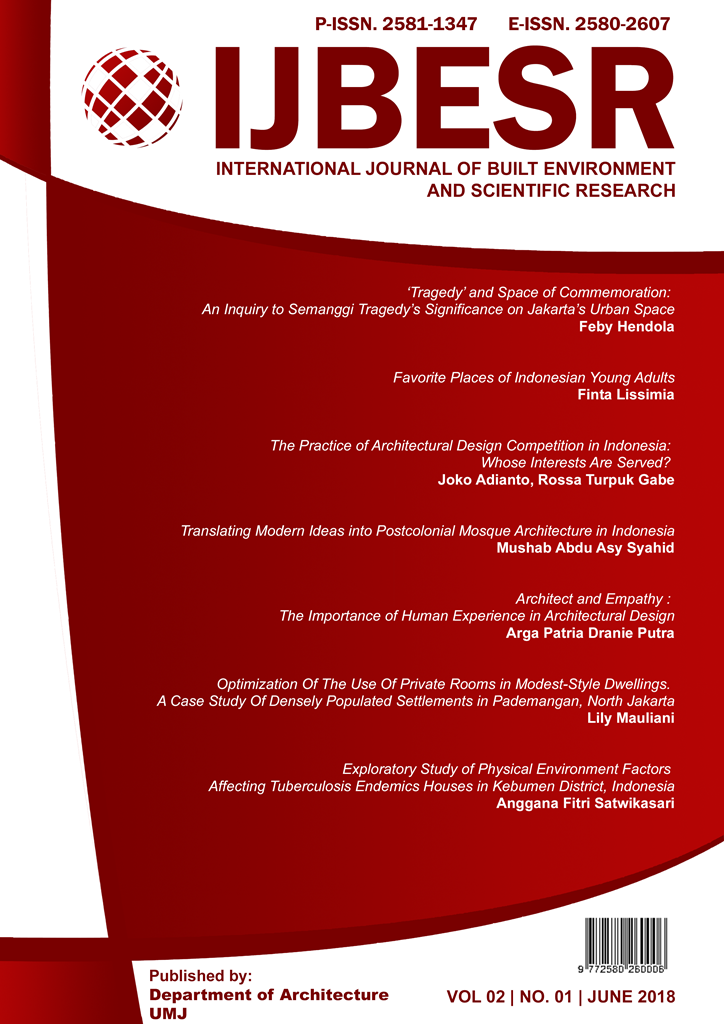The Practice of Architectural Design Competition in Indonesia: Whose Interests Are Served?
DOI:
https://doi.org/10.24853/ijbesr.2.1.27-38Keywords:
architecture, design, competition, infringements, users, interest.Abstract
Architecture Design Competition (ADC) has been acknowledged as one of the prominent methods to serve the best of public interest. However, the spatial infringements frequently occur as the indication of the incompatibility between the best results and the needs of the users. A multi-stages qualitative research was done, in Jatinegara Vertical Rent Housing as a selected case study, and aimed to identify the incompatibility. The disproportion of the available time with the required outputs emerges as the scapegoat of the capitulation of criticality to overcome the incompatibility. Moreover, the exclusion of the designated users in the whole stages of ADC is the essential cause, as an embodied misconception of the definition client-user in the professional practice. The finding of this research addresses several recommendations to reclaim the criticality in ADC and save the practice of this profession from the mortifying failure to serve the best public interest.References
Guilherme, Pedro Miguel Hernandez Salvador. 2014. Competitions serve a larger purpose in architectural knowledge, Architecture & Education Journal, 11: 425-451.
Cuff, D. 1991. Architecture: the story of practice. Cambridge: MIT Press.
Stevens, G. 1998. The Favored Circle: The Social Foundations of Architectural Distinction. London: MIT Press.
Kostof, S. 2000. The architect. Berkeley: University of California Press.
Adamczyk, Georges. 2004. Architectural competitions and new reflexive practices, Dublin: ARCC – AEEA.
Arrowsmith, S. 2005. The law of public and utilities procurement. London: Sweet & Maxwell.
Gifford, R. 2002. Environmental psychology: principles and practice. Coleville, WA: Optimal Books.
Volker, L., Lauche, K., Heintz, J. L., de Jonge, H. 2008. Deciding about design quality: design perception during a European tendering procedure. Design Studies, 29(4): 387-409.
Volker, L. 2012. Procuring architectural services: sensemaking in a legal context. Construction Management and Economics, 30(9): 749-759.
Collyer, G. S. 2004. Competing globally in architecture competitions. Hoboken, NJ: Wiley-Academy.
Van Wezemael, J.E. 2008. The complexity of competitions: the quest for an adequate research design. Stockholm: Conference Architectural Competitions.
Sengers, McCarthy, Dourish. 2006. Reflective HCI: Articulating an Agenda for Critical Practice. Conference on Human Factors in Computing Systems (CHI). New York: ACM Press.
Malmberg, C (eds). 2006. The politics of design: competitions for public projects. Anaheim, CA: PrintMedia Communications.
Knack, R. E. 1990. Design-development competitions: the case of Bunker Hill. Journal of Architectural and Planning Research, 7(2): 160-171.
Pratiwi, Nyi M. 2008. Faktor-faktor yang Mempengaruhi Masyarakat Tetap Tinggal di Daerah Rentan Bencana (Studi Deskriptif Pada Masyarakat Kampung Pulo, Kelurahan Kampung Melayu). Depok: Skripsi Universitas Indonesia.
Shalih, Osmar. 2012. Adaptasi Penduduk Kampung Melayu Jakarta Terhadap Banjir Tahunan, Depok: Skripsi Universitas Indonesia.
Rendell, J. 2000. Architectural Research and Disciplinarity. Architectural Research Quarterly 8(2): 141-148.
Forty, A. 2000. Words and buildings a vocabulary of modern architecture. London: Thames and Hudson.
Ellis, W. R., Cuff, D. 1989. Architects' people. Oxford: Oxford University Press.
Pressman, A. 1995. The Fountain Headache: The Politics of Architect-Client Relations, New York: John Wiley & Sons.







